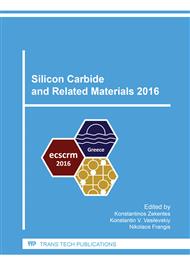[1]
Y. Yamamoto, S. Harada, K. Seki, A. Horio, T. Mitsuhashi, and T. Ujihara, Appl. Phys. Express, 5 (2012) 115501.
DOI: 10.1143/apex.5.115501
Google Scholar
[2]
S. Harada, Y. Yamamoto, K. Seki, A. Horio, M. Tagawa, and T. Ujihara, Acta Mater. 81 (2014) 284.
Google Scholar
[3]
S. Harada, Y. Yamamoto, K. Seki, A. Horio, T. Mitsuhashi, M. Tagawa, and T. Ujihara, APL Mater. 1 (2014) 022109.
Google Scholar
[4]
S. Harada, Y. Yamamoto, K. Seki, and T. Ujihara, Mater. Sci. Forum, 740-742 (2013) 189.
Google Scholar
[5]
Y. Yamamoto, S. Harada, K. Seki, A. Horio, T. Mitsuhashi, D. Koike, M. Tagawa, and T. Ujihara, Appl. Phys. Express, 7 (2014) 065501.
DOI: 10.7567/apex.7.065501
Google Scholar
[6]
K. Kusunoki, S. Munetoh, K. Kamei, M. Hasebe, T. Ujihara, and K. Nakajima, Mater. Sci. Forum, 457-460 (2004) 123.
DOI: 10.4028/www.scientific.net/msf.457-460.123
Google Scholar
[7]
K. Danno, H. Saitoh, A. Seki, Y. Fujiwara, T. Ishii, H. Sakamoto, and Y. Kawai, Mater. Sci. Forum, 645-648 (2010) 13.
Google Scholar
[8]
T. Mitani, N. Komatsu, T. Takahashi, T. Kato, K. Fujii, T. Ujihara, Y. Matsumoto, K. Kurashige, and H. Okumura, J. Cryst. Growth, 401 (2014) 681.
DOI: 10.1016/j.jcrysgro.2013.11.031
Google Scholar
[9]
S. Harada, K. Seki, Y. Yamamoto, C. Zhu, Y. Yamamoto, S. Arai, J. Yamasaki, N. Tanaka, and T. Ujihara, Cryst. Growth Des., 12 (2012) 3209.
Google Scholar
[10]
K. Maier, J. Schneider, W. Wilkening, S. Leibenzeder, and R. Stein, Mater. Sci. Eng., B11 (1992) 27.
Google Scholar
[11]
A. Uddin, H. Mitsuhashi, and T. Uemoto, Jpn. J. Appl. Phys., 33 (1994) L908.
Google Scholar
[12]
A. Horio, S. Harada, D. Koike, K. Murayama, K. Aoyagi, T. Sakai, M. Tagawa, and T. Ujihara, Jpn. J. Appl. Phys., 55 (2016) 01AC01.
DOI: 10.7567/jjap.55.01ac01
Google Scholar
[13]
D. M. Cupid and H. J. Seifert, J. Phase Equilib. Diff., 28, (2007) 90.
Google Scholar
[14]
H. M. Chen, Y. Xiang, S. Wang, F. Zheng, L. B. Liu, and Z. P. Jin, J. Alloys Compd., 474 (2009) 76.
Google Scholar
[15]
H. Nowotny, E. Parthe, R. Kieffer, and F. Benesovsky, Monatsh. Chem. (1954) 255.
Google Scholar
[16]
M. Kado, H. Daikoku, H. Sakamoto, H. Suzuki, T. Bessho, N. Yashiro, K. Kusunoki, N. Okada, K. Moriguchi, and K. Kamei, Mater. Sci. Forum 740-742 (2013) 73.
DOI: 10.4028/www.scientific.net/msf.740-742.65
Google Scholar


